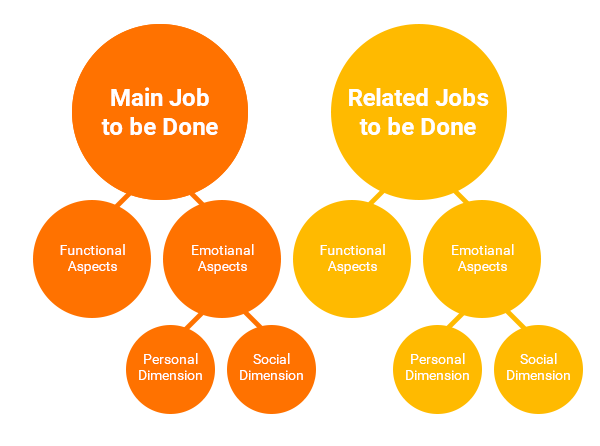Just as I was returning to my job at Octopus Investments after maternity leave, I was asked to lead the creation of a new portal for our customers.

The idea was for the portal to function as a single hub where all our customers could manage their investments online — an awesome opportunity, but a big challenge. My first step was to decide how to approach it.
The Jobs-to-be-Done framework was at the top of my list. At the core of this framework is a really simple concept that helps drive all of your product development. Let me tell you more.
The core principle of the Jobs-to-be-Done framework is as follows: to create a product or service that your customer wants, you need to understand what they’re trying to do with it.
As the saying goes, no one wants a quarter-inch drill bit; they want a quarter-inch hole.
What is Jobs to be Done
Visit http://jobstobedone.org for more info. also you can find the Jobs to be Done community at the #JTBD on twitter. Online Course to learn how we find the JTBD through Interviews: http://learn.jobstobedone.org/ (thanks Kijuyswe2134)
For example, the portal I was tasked to build would allow the customers of Octopus Investments to manage their investments online, but I knew that was too simplistic for some customers.
The main customer of Octopus Investments is a financial adviser who works with clients to understand their financial goals and advise on strategies to achieve them. So, if they have placed a client’s money with us, the job they are doing is providing ongoing service to that customer, which may include conducting regular reviews on how the investment is performing, answering ad-hoc questions, and more.
While, on the surface, the customer may want to know the current value of the investment, what they needed to do was to get that number, understand any changes, and communicate it in a variety of formats. This called for a very different design.
Although product management is a relatively new practice, it often builds on tools and techniques that have been around for a while. Invented by Tony Ulwick when he founded his company Strategyn, the Jobs-to-be-Done framework dates back to 1991.
Ulwick and Christensen: The Birth of Jobs to Be Done (Spring 2000)
To learn more about Jobs to be Done and Outcome Driven Innovation, be sure to visit https://strategyn.com/. Strategyn’s Anthony Ulwick introduces Clay Christensen to the concept and model of “Jobs-to-be-Done” before it was called Jobs to be Done. Ulwick demonstrates the value of the Outcome-Driven Innovation process.
Ulwick believed that companies needed a scientific way to innovate. To gain deep insight into the customer’s needs, he posited, companies should stop focusing on the product or the customer and instead seek to understand what the customer is trying to achieve using that product or service.
Ulwick has applied this philosophy to help companies deliver amazing successes through a process called outcome-driven innovation (ODI). In 1999, he introduced ODI to Harvard professor Clayton Christensen, who popularized the theory in his book, “The Innovator’s Solution” and labeled the theory as Jobs-to-be-Done.
Between the work of Ulwick and Christensen, the Jobs-to-be-Done theory has proven to be an extremely effective tool when building products and services for customers.
There are nine tenets that underpin the Jobs-to-be-Done theory. Let’s examine each tenet to help us understand the framework in more detail.
Think about the last thing you purchased. Why did you purchase it? What did it help you achieve?
Maybe you purchased lunch because you didn’t want to be hungry. But did you also consider whether that lunch you purchased helped if you are following a particular diet, or whether it could be prepared during the brief break you have between meetings? Or perhaps that choice allowed you to sit down so you could catch up with a friend.
Taking the example of lunch, the functional component is simple: you want to quench your hunger.

The social bit might be to allow you to eat with friends. The emotional piece might be around supporting certain health aspirations or conditions.
We’ve needed to eat lunch for a very long time! You will know you’ve found the actual job to be done if this tenent proves true. It then helps provide a unit of focus that does not change, no matter what else changes around it.
In fact, customers get to choose the solution that suits them best.
Looking back at the portal I built: before it existed, customers were able to manage their investments with us by using phone or email. I had good evidence that the portal would do a better job than those channels, but I knew I needed to make the jobs they had to do easier and more efficient to do online than using those traditional channels.
Understand the job the customer is trying to achieve and you will discover what needs you have to meet to make your product successful in completing that job.
After my team and I started to unpack what it meant for a financial adviser to do a review for a client, the things they needed to do, the way in which they needed to present themselves etc., we began to discover how to position various aspects of the portal to make them — and, therefore, the product — successful.
If you truly understand what the customer is trying to achieve — i.e., the job they are looking to do — then you are going to be able to speak their language at the right time, making your product marketing efforts more effective.
As for innovation, you can see where existing solutions are letting customers down and solve those problems, potentially inventing something novel.
Customers are not loyal to the brand or product, but they do need that job done.
Customers will switch, so can you take advantage of that, or do you need to defend your position as their favored option?
For me, the process of booking a holiday illustrates this best. Getting that job done often means working across many platforms to get what I need — so much so that I inevitably end up back at a single platform to get most of it done.
Customers want simplicity, so understanding the whole job that the customer needs to be done will help you support them completely.
Getting alignment on what it means to be successful is imperative for product teams. The Jobs-to-be-Done framework stipulates that meeting the needs that enable customers to complete the job are the measurable outputs of success. Also, these won’t change over time, allowing for long-term measurement.
The first success using this framework was when Strategyn worked with Cordis Corporation to introduce a new line of angioplasty balloons. They focused on what the medical personnel were trying to achieve before, during, and after the surgery and designed products to meet these needs.
Their research also showed that they had products that were likely to fail, so they stopped costly production on these products. This led to a dramatic increase in market share from about 1 percent to more than 20 percent.
I love the story about the dining room table as told in this Harvard Business Review article. A property development was struggling to sell houses to people looking to downsize and they couldn’t understand the conflicting feedback they were getting. Potential customers kept referencing not being able to fit a dining room table as a reason why they didn’t want to purchase, but didn’t list a formal dining room in their requirements.
When it became apparent that, without room for a table, potential buyers would be unable to host family gatherings, the team had the insight they needed to successfully sell the properties.
My company was also successful in implementing the Jobs-to-be-Done framework. Since launch, we’ve had 10,000 new customers online and increased our channel share (measured by the number of contacts we have online, over the phone, and via email) from 40 percent to 60 percent — as well as some really lovely comments from our customers about how easy it is to use our portal.
Jobs-to-be-Done is a simple framework that puts emphasis on the “why” behind what a customer is doing. It gives a unit of focus — the job the customer is looking to do — to build measurable ways of looking at success that do not change over time.
The examples above show how Jobs-to-be-Done can be used across a variety of industries and products beyond software. They teach us that to mimic these successes and, above all else, ensure you keep the focus on understanding the job the customer wants to do and producing a solution that does it brilliantly.
To learn more about the Jobs-to-be-Done framework, download out Ulwick’s free e-book, “Jobs-to-be-Done: Theory to Practice.”
Featured image source: IconScout

LogRocket identifies friction points in the user experience so you can make informed decisions about product and design changes that must happen to hit your goals.
With LogRocket, you can understand the scope of the issues affecting your product and prioritize the changes that need to be made. LogRocket simplifies workflows by allowing Engineering, Product, UX, and Design teams to work from the same data as you, eliminating any confusion about what needs to be done.
Get your teams on the same page — try LogRocket today.

Most teams fail at autonomy. Learn how clear rules help product teams move faster without micromanagement.

A practical framework for PMs to use AI in ideation without sacrificing judgment, strategy, or decision quality.

A practical five minute revenue estimation method to help product managers compare ideas, drop low impact features, and prioritize smarter.

A practical guide for PMs who want to stop being bottlenecks, delegate smarter, and lead teams effectively with a clear ownership framework.